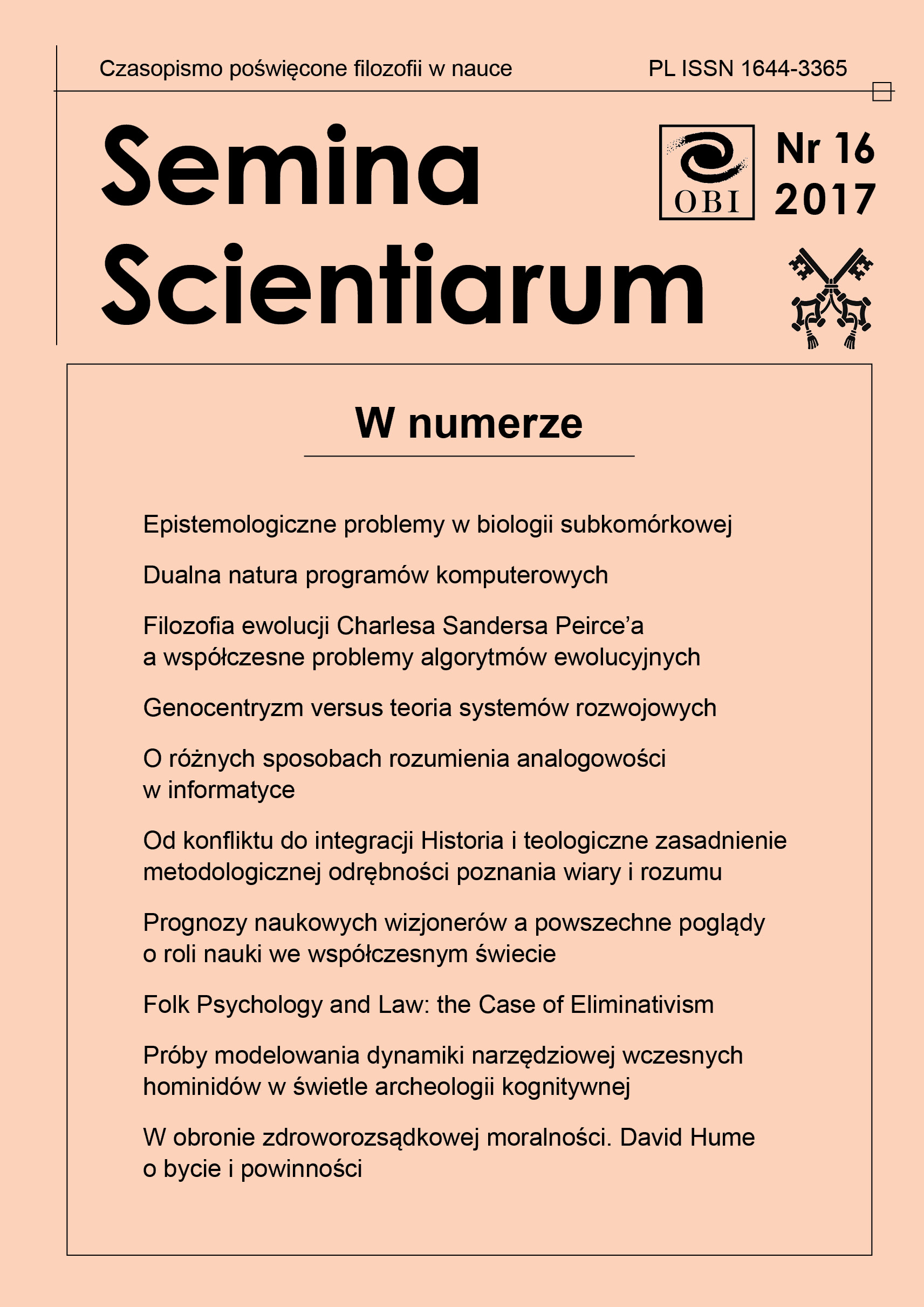Filozofia ewolucji Charlesa Sandersa Peirce’a a współczesne problemy algorytmów ewolucyjnych
DOI:
https://doi.org/10.15633/ss.2484Słowa kluczowe:
evolutionary algorithms, genetic algorithms, Neo-Darwinism, Charles Sanders Peirce, the theory of evolutionAbstrakt
The article challenges the view that the Neo-Darwinian theory of evolution
is sufficient to explain the ongoing evolution. The classical evolutionary algorithms
based on that theory suffer from the loss of diversity, stagnation and
premature convergence. The author claims that the cosmetic changes of those
tools are not sufficient to overcome this situation and the change of overall theoretical
framework is required. The proposition of a semiotic theory of evolution
created by Charles Sanders Peirce is revealed as an alternative to the classical
Modern Synthesis. This alternative model of evolution is implemented in
two kinds of evolutionary algorithms: P-EA and SEAM, which simulate evolution
by virtue of cooperation and symbiosis respectively. The new approach to
algorithms constructs shows significant benefits upon classical evolutionary
algorithms in benchmark tests, which may support the original claim that the
accepted theory of evolution needs rethinking today.
Bibliografia
Akhtar J., Koshul B. B., Awais M. M., A Framework for Evolutionary Algorithms
Based on Charles Sanders Peirce’s Evolutionary Semiotics, „Information
Sciences” 236 (2013), s. 93–108.
Collected Papers of Charles Sanders Peirce, ed. C. Hartshorne, P. Weiss,
A. Bruks, vol. 1–8, Cambridge 1931–1960.
Adam Kłóś
Delisle R. G., The Uncertain Foundation of Neo-Darwinism: Metaphysical
and Epistemological Pluralism in the Evolutionary Synthesis, „Studies in
History and Philosophy of Biological and Biomedical Sciences” 40 (2009),
s. 119–132.
Flasiński M., Wstęp do sztucznej inteligencji, Warszawa 2011.
Forbes N., Imitation of Life. How Biology Is Inspiring Computing, Cambridge
Gould S. J., Eldredge N., Punctuated Equilibria: the Tempo and Mode of Evolution
Reconsidered, „Paleobiology” 3 (1977) no. 2, s. 115–151.
Jablonka E., Lamb M. J., Evolution in Four Dimensions. Genetic, Epigenetic,
Behavioral, and Symbolic Variation in the History of Life, Cambridge
Khakhina L. N., Concepts of Symbiogenesis: A Historical and Critical Study
of the Research of Russian Botanists, ed. M. Margulis, M. McMenamin,
London 1992.
Margulis L., Sagan D., Acquiring Genomes: A Theory of the Origin of Species,
New York 2002.
Peirce C. S., Ewolucyjna miłość (Evolutionary Love), tłum. M. Manna, „Logos
i Ethos” (2010), s. 141–175.
Smith J. M., Szathamáry E., Tajemnice przełomów ewolucji. Od narodzin życia
do powstania mowy ludzkiej, tłum. M. Madaliński, Warszawa 2000.
The Essential Peirce. Selected Philosophical Writings, vol. I: 1867–1893, ed.
N. Houser, C. Kloesel, Bloomington–Indianapolis 1992; vol. II: 1893–1913,
ed. The Peirce Edition Project, Bloomington–Indianapolis 1995.
The New Elements of Mathematics by Charles S. Peirce, ed. C. Eisele, vol. 1–4,
Hague 1976.
Watson R. A., Compositional Evolution: The Impact of Sex, Symbiosis, and
Modularity on the Gradualist Framework of Evolution, Cambridge 2006.
Watson R. A., Pollack J. B., A Computational Model of Symbiotic Composition
in Evolutionary Transitions, „BioSystems” 69 (2003), s. 187–209.
Writings of Charles S. Peirce: A Chronological Edition, ed. The Peirce Edition
Project, vol. 1–6, 8, Bloomington–Indianapolis 1982–201?.
Pobrania
Opublikowane
Numer
Dział
Licencja
Twórca oświadcza, że przysługują mu prawa autorskie do utworu i że nie są ograniczone w zakresie objętym niniejszym oświadczeniem oraz że utwór jest dziełem oryginalnym i nie narusza praw autorskich innych osób.
Twórca zezwala Uniwersytetowi Papieskiemu Jana Pawła II w Krakowie na nieodpłatne, niewyłączne i nieograniczone w czasie korzystanie z utworu, to jest:
- utrwalanie i zwielokrotnianie: wytwarzanie egzemplarzy utworu techniką drukarską, reprograficzną, zapisu magnetycznego oraz techniką cyfrową;
- obrotu oryginałem albo egzemplarzami, na których utwór utrwalono (wprowadzanie do obrotu, użyczenie lub najem oryginału albo egzemplarzy, publiczne wystawienie, wyświetlenie, a także publiczne udostępnianie utworu w taki sposób, aby każdy mógł mieć do niego dostęp w miejscu i w czasie przez siebie wybranym);
- włączenie utworu w skład utworu zbiorowego;
- udzielanie przez Uniwersytet Papieski Jana Pawła II w Krakowie sublicencji Creative Commons Uznanie autorstwa-Użycie niekomercyjne-Bez utworów zależnych 3.0 Polska
Uniwersytet Papieski Jana Pawła II w Krakowie udostępnia utwór na Platformie Czasopism należącej do uczelni, na licencji Creative Commons Uznanie autorstwa-Użycie niekomercyjne-Bez utworów zależnych 3.0 Polska. Tym samym uprawnia wszystkich zainteresowanych do korzystania z utworu pod następującymi warunkami:
- zostanie podany autor i tytuł utworu,
- zostanie podane miejsce publikacji (tytuł czasopisma i adres internetowy do oryginalnie opublikowanego utworu),
- utwór będzie dystrybuowany w sposób niekomercyjny,
- nie będą tworzone utwory zależne.

